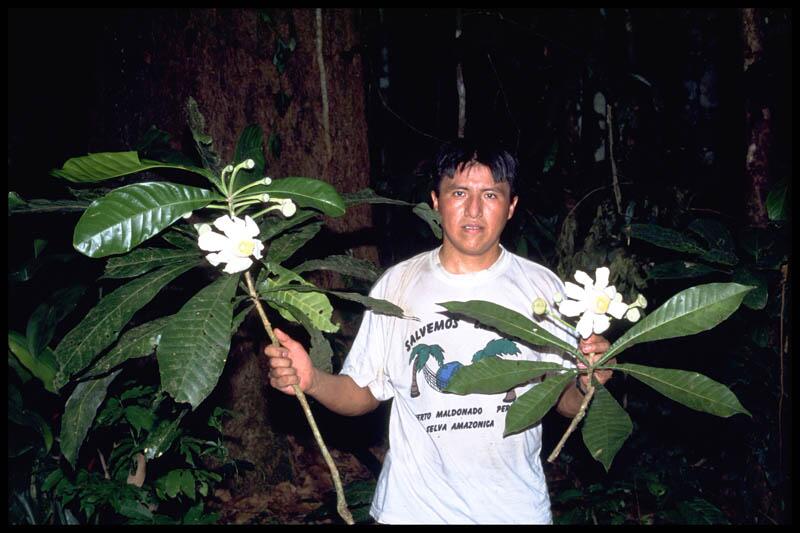Lecythidaceae
Gustavia augusta L.

Kingdom: Plantae Rank: Species Parent: Gustavia Status: Valid
Common Names:
- Chope (Peru). - English, Peru
Taxonomic Classification
Classification: The large actinomorphic flowers and black seeds with a yellow aril characerize this species.
Morphological Description
Diagnosis: Usually small trees with large leaves that are broader above the middle; flowers actinomorphic and large (≥ 9 cm diam.); fruits indehiscent, globose; and seeds black with a yellow, contorted funicle.
Vegetative Morphology
Habit: Trees, understory, to 22 m tall. Trunks not buttressed. Bark scalloped, the inner bark reddish.
Leaves: Leaves from twigs 5-10 mm diam.; petioles absent to 40 mm long; blades 16-48 x 4-13 cm, narrowly obovate to oblanceolate, glabrous, domatia absent; base acute to cuneate; margins entire to serrulate, infrequently serrate; apex acute or acuminate; secondary veins in 14-22 pairs, the tertiary veins weakly percurrent.
Stipules: Stipules absent, at least in adult trees.
Exudate: Exudate absent.
Reproductive Morphology
Inflorescence: Inflorescences usually terminal, less frequently axillary or cauline, racemose; pedicels 15-75 mm long.
Flowers: Flowers 9-15 cm diam.; calyx-lobes nearly absent or of 4 broadly rounded or triangular lobes; petals (6)8(9), white, often with tinges of pink; androecium with filaments white throughout or white toward base and pink toward apex; ovary 4-7-locular.
Fruit: Fruits indehiscent, 3-7 x 3-8 cm, globose, truncate at apex.
Seeds: Seeds black, with yellow, contorted funicle.
Other
Uses: In French Guiana, Creóles around St. Georges use the inner bark or young leaves mixed with kaolin in cold water as a remedy for vomiting in children. The Palikur Indians use the fruits (seeds), bark, or young leaves to make a plaster that is applied to the lesions caused by leishmaniasis. A juice extracted from the bark and leaves of G. augusta is drunk from the fruit of another Lecythidaceae, the canari macaque (Lecythis zabucajo Aubl.), as a remedy for dizziness (Grenand et al., 2004). The label of Jangoux 756 states that a tea made from the bark is used to treat snake bite by the Urubu-Kaapor Indians of Brazil. The fruits are reported to be edible on the labels of some Peruvian collections (Peters 3, Peters 9, Tessmann 3410) and the seeds are reported to be a source of oil on the label of Krukoff 1072. Label data also indicate that the wood is used in house construction (Diaz 6143) and for tool handles (Krukoff 1072, Rosales 58). Gustavia augusta is occasionally grown as an ornamental.
Distribution: A widespread Guianan and Amazonian species found in eastern Guyana, Surinam, French Guiana, and Amazonian Brazil. It also occurs in the northern part of the Atlantic coastal forest of Brazil.
Ecology: Gustavia augusta is a common riverine species that less commonly occurs in non-flooded habitats. Poiteau (1825) noted that this species is more common in more open areas than it is in dense forest, and that it readily sprouts from the base after it has been cut.
Chromosome Number: A count of x = 18 is probably wrong as three other counts of other species of Gustavia are x = 17 or x = 34 (see Kowal, 1989).
Notes: Schönberg et al. (2002), in a study of the phenology of species in an Amazonian floodplain forest near Manaus, report that G. augusta is an evergreen species. It flushes new leaves and sheds senescent leaves throughout the year, and is never leafless at any time during the year. The open flowers of Gustavia augusta are visited by many different insects but are most efficiently pollinated by bees. The seeds of G. augusta are surrounded by an edible pulp and possess a yellow, contorted funicle that may also be edible. We have seen fruits of this species that have been gnawed open by animals. Roosmalen (1985) reports that spider monkeys disperse the seeds of species of Gustavia endozoochorously and that scatter-hoarding animals carry away the seeds after the fruits fall to the ground. Grenand et al. (2004) report that the brown capuchin monkey (Cebus apella) eats the fruits.
Typification
Type Citation: Dissert. Fl. Surinam 17-18, t.12. 1775.
Basionym: Not applicable.
Basionym Citation: Not applicable.
Type Locality: Surinam: without specific locality.
Type Collection: Probably Dahlberg s.n. but this not known with certainty.
Types Deposited at: Holotype: Lectotype, LINN microfiche 863.2; Isotypes: Isolectotypes, LINN microfiche 863.1 and LINN microfiche 863
Other Published Figures: Bot, Univ. São. Paulo 14: fig. 1 – habit, fl, fr, seed.